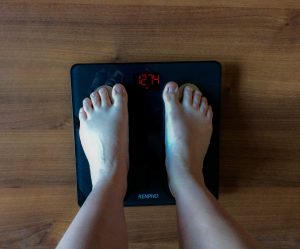America seems obsessed with “weight loss” everywhere you look. Unfortunately, this concept is too frequently conflated with “fat loss” and more highly valued without taking body composition changes into account in most cases. Teasing out the differences both conceptually and physiologically, and making a clear distinction between fat loss and weight loss can help personal trainers better support clients on their fitness journey.

Weight loss as a topic is on the cover of practically every fitness magazine and floods social media minute to minute with photos, hashtags and personal weight-loss accounts. Instagram influencers push pills, powders or shakes claiming to melt fat away in thirty days or less!
If it sounds too good to be true, it probably is; this can explain why the average weight loss client becomes so frustrated with the true pace of attaining wellness goals. Often clients misunderstand why their weight hasn’t changed after putting in hard work and can also see their physical progress in their own appearance. Or worse, they wonder why their weight is increasing when they are working so hard to lower the number on the scale.
Here are three areas that can help your clients gain a better understanding of how fat loss differs from weight loss.
Body Composition is Key
This is a subject that I return to time and again to help clients wade through their frustration and confusion. From my experience as someone who has struggled with negative body image and as a certified personal trainer, it seems that most people who want to lose weight don’t always understand that the process is more complex than just losing pounds.
 It’s like this: they see their body as bones and muscles and then covering all of that is ugly fat, and usually, they believe lots of it. Your average client doesn’t understand the intricacies of the body, how processes are intertwined, and parts are all connected. Or how vital fat is to our body’s immune system.
It’s like this: they see their body as bones and muscles and then covering all of that is ugly fat, and usually, they believe lots of it. Your average client doesn’t understand the intricacies of the body, how processes are intertwined, and parts are all connected. Or how vital fat is to our body’s immune system.
Let’s say the client is a woman who weighs 150lbs. and she wants to be 130lbs. She’s thinking she has an extra 20lbs. of fat that she could get rid of if she works hard enough and diets. She’s stuck on this number; she wants to be 130lbs. She goes to her trainer and says she wants to lose weight. She tells the trainer she misses wearing her old jeans and dresses, and that she wants her energy back.
This client’s true goals aren’t actually about being a certain weight. If you’re truly listening to her, you’ll understand it’s about how she fits into her clothes and feels throughout her day. However, it can be incredibly challenging to help the client understand this, even when reflecting back her own words.
Clients that have been told their whole life by society and media that they must be a certain weight to be attractive and may struggle to grasp that they can lose fat mass and simultaneously gain lean muscle. This phenomenon of physiology explains why there may be little to no change in weight, yet clothing sizes get smaller, they feel amazing, they can work harder and longer in the gym, and they look fantastic.
The weight in fat they lost was replaced with the same weight in muscle. Muscle tissue is just more compact; which is why circumferences of the body can be smaller, but the number on the scale hasn’t changed much, if at all. This makes it vital to do circumference measurements, especially on clients who ultimately want to look and feel good. This way when the client is frustrated or confused by the number on the scale, the trainer can show them the changes in their measurements. This ensures the client has the outcome data to validate their hard work, and help keep them feeling motivated and encouraged.
Having the “body composition” conversation is even more important to have with the client that specifically references how clothes fit and how they want to feel. Some clients know exactly what their body and fitness goals are, and truly need to be within a certain, healthy body weight range. Usually, these clients are extremely overweight and are understandably looking for overall weight loss (naturally, it is still fat or adipose tissue that must be lost, but monitoring the number on the scale matters here).
Be sure to listen to the client, how they talk about their goals and what they want out of their sessions. This will tell you every time what you should focus on.
Being Honest About Diet
Depending on certifications and scope of practice, there is only so much a trainer can influence when it comes to nutrition. With the average personal training cert, a fit pro can offer broad guidelines and suggestions to what a healthy diet entails. However, it is not out of scope to be frank with the client about how important diet is concerning fat loss and overall health, and to point out areas that need improvement. Most people don’t realize how much impact food has on fitness goal progress. It’s a terrible misconception that one can lose fat while eating freely just because he or she is still working out often.
We may also have to offer a reality check to the client who simply isn’t being honest with themselves about what they are eating and how much. This client will be upset with their lack of progress and possibly blame the trainer for this. It’s tough for a trainer when we only see clients for a fraction of the week depending on how many sessions they come in for. If you notice the client isn’t losing weight or changing body composition, yet they are putting in the hard work in sessions (and on their own), there’s only one variable to blame: diet.
This is where honesty comes in. Have the conversation with your client. Let them know you can only “lead a horse to pasture” when it comes to their nutrition. At the end of the day, they have to own their choices. While you are there to coach, guide and encourage them through the difficult challenges associated with weight/fat loss, hand-holding can only take someone so far. Talk about the importance of food and how it can help or hurt the client’s goals. Underscore the importance of honesty with themselves, and that they will only make significant changes in the gym if they make consistent and positive changes in the kitchen.
Spot Specific Exercises
The misconception that spot reduction is possible drives me crazy. It is something that caused me a lot of frustration and confusion as a young girl. Almost every, single client I have worked with believed in spot specific exercises. I have so frequently been asked the question, “What exercises can I do to reduce my (insert body part) fat?”
Ummm… all of them?
This is a pretty simple subject to cover with clients. It’s a yes-or-no sort of question. Do certain exercises reduce fat in specific places of the body? Absolutely not. Yet, I continue to see these magical exercises claiming to “burn belly fat” or “get rid of muffin top” blasted all over magazines.
As a trainer, you know that fat loss doesn’t work this way, and rather, it’s a gradual process that can be different for each person. This is what the client needs help understanding. Generally, fat is first lost in places of least importance so far as vital purpose goes: face, arms and legs.
The torso which houses all the vital organs will tend to stubbornly retain excess fat for most people. That’s because fat is a good thing in biology; it’s a protector and energy storehouse. Explaining this concept also helps the client understand the body is ultimately trying to protect itself. From a biology standpoint, a little extra fat around the midriff is A-Okay. This ensures the organism will be safe in the case of famine or severe cold.
Despite what many fitness enthusiasts tend to believe, the body isn’t going to burn more fat around the belly because one does a ton of crunches. The abdominal muscles will be strengthened, but the fat can easily remain.
Fat loss is hard work and takes consistent work over long periods of time. Depending on how much fat loss is desired, it can be a journey. Most goals won’t be met in a month or achieved by taking supplements or diet pills. However, losing fat is achievable and something anyone can do with the right approach.

Keep encouraging your clients to continue working hard and loving themselves through the process. Continue to discredit “get skinny quick” schemes and endorse evidence-based methods. Trainers are a big part of changing the script about fat loss and how it all works.
It’s not realistic to expect that running until you can’t anymore and only eating iceberg lettuce is the path to successful, sustainable weight loss. Once a client decides they want to lose the fat, they must implement a change in lifestyle that involves consistently picking healthy foods, working out regularly and being kind to oneself. Helping your clients truly grasp this long-term approach will improve their chances for fitness and weight loss success.
Alex has her A.S in Exercise Science and is a certified Personal Trainer with NFPT and NSCF. She recently traveled to India to gain her 200 hr yoga teacher certification where she studied the ancient practice at its origins. Alex has spent time teaching yoga in Spain while volunteering at a yoga retreat and is currently working at her local college instructing two fitness courses. Alex wants to share with her clients and students the mental, physical and emotionally healing qualities of exercise and movement. She believes everyone should have a healthy relationship with their bodies and strives to thread that concept throughout her career.

